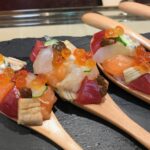New fish burger
Things tend to change over time, and I don’t think tradition should be rigid. Do you have a taste that hasn’t changed in ages? When asked, I say there’s almost nothing that hasn’t changed its taste in a hundred years. I read it somewhere, but I think the traditional tastes were mostly just my own and the ones I remember from my past. Except for Shinto and Buddhist rituals, I don’t think you’ll find anything in cooking that hasn’t changed in a hundred or two hundred years. Even sushi, the taste of the shari(sushi rice) in the era when sugar was rare would be vastly different from today. And even Yahata sushi has been reduced in salt when the fourth generation was young (about fifty years ago). I sometimes wonder if it’s harder to change with the times and people’s tastes than to stick to one taste through the ages. For instance, even if a cucumber roll was invented by the fourth generation right after the world war 2, back then, no one thought of eating cucumbers raw, so the predecessors didn’t accept it at first. It was the fifth generation who came up with it. Zuiun of sea urchin, which is now super popular with Kappa maki(cucumber roll), was also hard for the fourth generation to accept. I’m the fifth generation of that thinking, so I’m always on the lookout for something new. A few years ago, I made a sandwich with grilled horse mackerel and Ankimo(steamed monkfish liver), and I finally finished the YahataSushi version of fillet o’fish. It’s wrapped in lettuce and eaten, and it’s now one of the types of omakase nigiri. I spread a thin layer of lightly roasted Ahkimo on the lettuce leaves, then drizzle sweet sauce of conger eel on top. I add a round-gripped sushi riceball on top, and I grill kamas(barracuda)on top of that. Sweet sauce is used for Ankimo, so to balance the sweetness and spiciness, grated red pepper &white radish and vinegar soy sauce are added on top of the kamasu. A green onion is also served on top to add color. Sometimes, avocados are used instead of shari, but they’re similar in texture, taste, and Ankimo, and they’re also part of nigiri sushi, so shari balls seem like a better choice. It’ll appear around the middle of the omakase nigiri, but everyone will love it. The fifth generation’s motto is “the customer will decide,” and I’m convinced by everyone’s big smiles ^^. Nigiri sushi was the main dish before the Edo period, but I think it’ll be fun to occasionally have it in the future, so yes. Please make a reservation for Omakase Nigiri at the counter.

It is common for things to evolve, and I don’t think tradition should be conservative. Do you often have a taste that has not changed for many years? When asked, I answer that there is nothing that has not changed its taste at all for a hundred years. I read it in some book, but I think that the subjective tradition was generally only in the period of my life and in the era in my memory. Apart from the traditions of Shinto and Buddhist rituals, I don’t think you see anything related to the taste of cooking that has not changed for a hundred or two hundred years. Even for sushi, the taste of shari in the era when sugar was precious will change greatly from today, and even Hachiman sushi has been significantly reduced in salt when the fourth generation was young (about fifty years ago). I sometimes wonder if it is much more difficult to reform according to the times and preferences than to follow one taste across eras and generations. For example, even if it was a cucumber roll invented by the fourth generation not long after the war, at that time when there was no idea of eating cucumbers raw, it was not accepted by the predecessors at first, and the fifth generation invented it. Zuiun of Untan, who is now gaining unwavering popularity with Kage-sama, was also difficult to be recognized by the fourth generation. I’m the fifth generation of that kind of thinking, so I’m always looking for something new. A few years ago, I made a sandwich of grilled horse mackerel and red liver, and the Hachiman Sushi version of fillet fish was completed. It is wrapped in lettuce and eaten, and it is currently served as one of the types of omakase nigiri. Lightly roasted bean paste is placed on top of lettuce leaves, and sweet sauce of conger eel is applied to the bean paste. On top of it, a round-gripped shari ball is stacked, and a grilled kamas is placed on top of it. Since sweet sauce is used for bean paste, in order to balance the sweet and spicy taste, grated maple and vinegar soy sauce are placed on top of the kamasu, and the green onion is served in the sky to color. Avocados are sometimes sandwiched instead of shari, but avocados are close in texture, taste, and bean paste, and they are served as part of nigiri sushi, so it seems that shari balls are more suitable. In order, it will appear around the middle of the omakase nigiri, but everyone will enjoy it with their eyes shining. The creed of the fifth generation is “the answer will be given by the customer”, so I am convinced by everyone’s big smile ^^ It is mainly nigiri sushi that has done the work before the Edo period, but I think it will be fun to occasionally appear in the immediate future, so yes. Please make a reservation for Omakase Nigiri at the counter.




